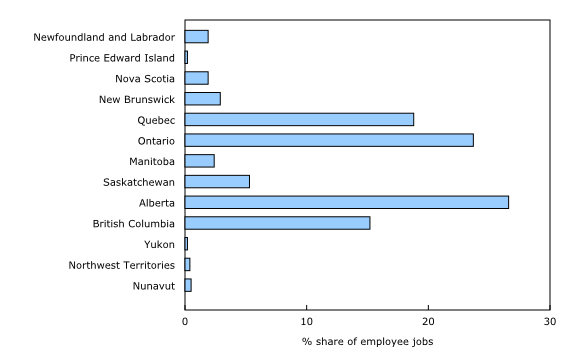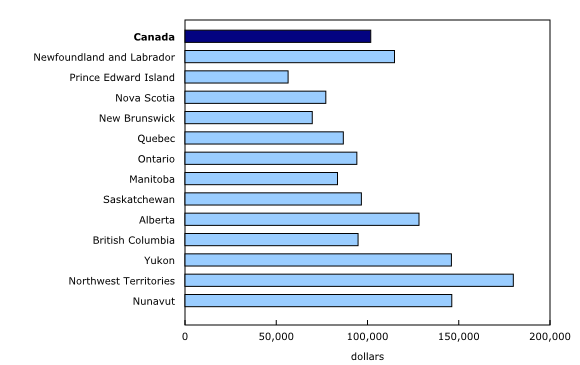Natural Resources Satellite Account: Human Resource Module, 2012 to 2021
Released: 2023-08-30
Natural Resources Satellite Account: Human Resource Module, 2021
In 2021, the natural resources sector employed 630,652 people, representing 3.6% of economy-wide employment. Of that number, 616,521, or 97.8%, were employee jobs, while the remainder were self-employed.
Provincially, the largest share of employee jobs in the natural resources sector was in Alberta, which employed 26.6% of the total natural resources sector workforce. Among all the provinces, Ontario (23.7%) and Quebec (18.8%) employed the second- and third-highest number of natural resources workers.
In 2021, natural resources employees earned an average of $101,789 per year in wages and salaries, compared with economy-wide average earnings of $62,459 per year.
Women hold one-fifth of jobs in the natural resources sector
In 2021, 20.7% of jobs in the natural resources sector were held by women, and this share has remained relatively unchanged from 2009, the first year of the Human Resources Module, to 2021. In 2021, the proportion of jobs held by women in the subsectors ranged from a high of 35.9% in the hunting, fishing and water subsector to a low of 16.1% in the mineral and mining subsector.
Nearly two-thirds of workers have postsecondary credentials
In 2021, 62.9% of natural resources workers possessed postsecondary diplomas. Workers in the energy subsector had the highest levels of educational attainment; 74.7% had more than a high school education and 57.2% had a college diploma or university degree. The subsectors with the lowest levels of postsecondary education were forestry and mineral and mining; 48.9% of forestry employees and 57.8% of mineral and mining employees had more than a high school education.
Growing share of workers aged 55 and older
From 2012 to 2021, similar to the economy-wide workforce, the age composition of employees in the natural resources sector shifted, with an increased share of workers aged 55 and older. In 2021, 24.8% of employees in the natural resources sector were aged 55 and older, while economy-wide, 24.0% of workers were aged 55 and older.
Rising share of visible minority, immigrant and Indigenous employees
From 2012 to 2021, the natural resources workforce became increasingly diverse, but at a slower pace than the overall labour force. In 2021, 18.8% of workers in the natural resources sector identified as being a part of a visible minority group, up from 15.3% in 2009. Economy-wide, 29.1% of workers identified as being a part of a visible minority group in 2021, up from 23.4% in 2009.
At the same time, immigrant workers represented 14.8% of natural resources employees in 2021, up from 13.5% in 2009. In 2021, the energy subsector had the largest share of immigrant employees, at 17.3%. In comparison, the downstream sector had proportionally more immigrant employees, at 29.5%.
In 2021, 6.8% of natural resources employees identified as Indigenous, up from 5.1% in 2009. In 2021, the subsector with the largest percentage of Indigenous employees was hunting, fishing and water (9.5%).
Note to readers
Human Resource Module (HRM) data for 2021 have been released along with the revised data from 2009. The revisions are primarily due to the incorporation of preliminary results from the Human Resource Module of the Canadian Economy (HRMCE), which provides annual estimates for 2009 to 2021, including provincial and territorial estimates.
These estimates are based on data from the Canadian Productivity Accounts and the Labour Force Survey. Census data for 2011, 2016 and 2021 and data from the National Household Survey are also incorporated. The HRMCE will be available upon release in late 2023.
The Natural Resources Satellite Account (NRSA) contains information on the number of jobs generated by the sector at the national, provincial and territorial level. The detailed information in the HRM complements and enhances the analytical capacity of the NRSA. The wages and salaries quoted here do not include Supplementary Labour Income and income from self-employment.
Additional information is presented in the articles, "The Natural Resources Satellite Account: Feasibility Study" and "The Natural Resources Satellite Account – Sources and Methods," which are part of the Income and Expenditure Accounts Technical Series (13-604-M) and are available from the "Subjects" module of our website.
Products
Special tabulations are available upon request.
Additional information can be found in the articles, "The Natural Resources Satellite Account: Feasibility study" and "The Natural Resources Satellite Account – Sources and methods," which are part of the Income and Expenditure Accounts Technical Series (13-604-M).
Contact information
For more information, or to enquire about the concepts, methods or data quality of this release, contact us (toll-free 1-800-263-1136; 514-283-8300; infostats@statcan.gc.ca) or Media Relations (statcan.mediahotline-ligneinfomedias.statcan@statcan.gc.ca).
- Date modified:


